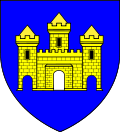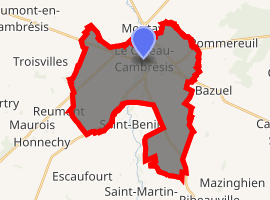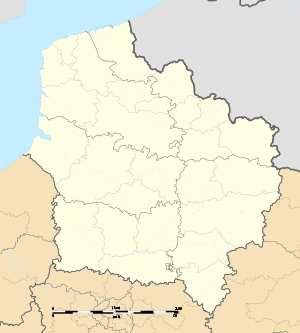Le Cateau-Cambrésis
Le Cateau-Cambrésis (French pronunciation: [lə kato kɑ̃bʁezi]) is a commune in the Nord department in northern France.
Le Cateau-Cambrésis | |
|---|---|
Le Cateau-Cambrésis by Auguste Herbin | |
 Coat of arms | |
Location of Le Cateau-Cambrésis 
| |
 Le Cateau-Cambrésis  Le Cateau-Cambrésis | |
| Coordinates: 50°06′15″N 3°32′40″E | |
| Country | France |
| Region | Hauts-de-France |
| Department | Nord |
| Arrondissement | Cambrai |
| Canton | Le Cateau-Cambrésis |
| Intercommunality | Communauté d'agglomération du Caudrésis - Catésis |
| Government | |
| • Mayor (2020-2026) | Serge Siméon |
| Area 1 | 27.24 km2 (10.52 sq mi) |
| Population (2017-01-01)[1] | 6,933 |
| • Density | 250/km2 (660/sq mi) |
| Time zone | UTC+01:00 (CET) |
| • Summer (DST) | UTC+02:00 (CEST) |
| INSEE/Postal code | 59136 /59360 |
| Elevation | 84–157 m (276–515 ft) (avg. 96 m or 315 ft) |
| Website | lecateau.fr |
| 1 French Land Register data, which excludes lakes, ponds, glaciers > 1 km2 (0.386 sq mi or 247 acres) and river estuaries. | |
The term Cambrésis indicates that it lies in the county of that name which fell to the Prince-Bishop of Cambrai.
History
- The Peace of Cateau-Cambrésis, ending the Italian Wars, was agreed there on 2–3 April 1559.
- Until 1678, the city belonged to the Spanish Netherlands (now called Belgium). France conquered the city officially by the treaty of Nijmegen signed in 1678.
- On 28 March 1794, allied forces under the prince of Coburg, defeated French forces at Le Cateau.
- Le Cateau formed the right wing of the front of II Corps of the British Expeditionary Force at the Battle of Le Cateau on 26 August 1914, during its withdrawal from the Battle of Mons.
Heraldry
 Arms of Cateau-Cambrésis |
The arms of Cateau-Cambrésis are blazoned : Azure, a 3-towered castle or. |
Matisse Museum
The Musée Départemental Henri Matisse installed in the Palais Fénelon in the center of Le Cateau boasts the third largest collection of Matisse works in France.
Notable people
Births:
- Henri Matisse, artist
- Marshal Mortier
- Pierre Nord
- Raymond Poïvet, one of the creators of the French science fiction comics Les Pionniers de l'Espérance
Pierre Mauroy was a high school student in Le Cateau, and later its representative at the general council for the Nord department.
Gallery
See also
References
External links
| Wikimedia Commons has media related to Le Cateau-Cambrésis. |
- Webpage (in French)
- Webpage about Le Cateau-Cambrésis (in French)
- Tourist Office (in English)
- Beffroivision, local TV channel
- Photographs from the Highland Cemetery in Le Cateau-Cambrésis
- "Populations légales 2017". INSEE. Retrieved 6 January 2020.
This article is issued from Wikipedia. The text is licensed under Creative Commons - Attribution - Sharealike. Additional terms may apply for the media files.

